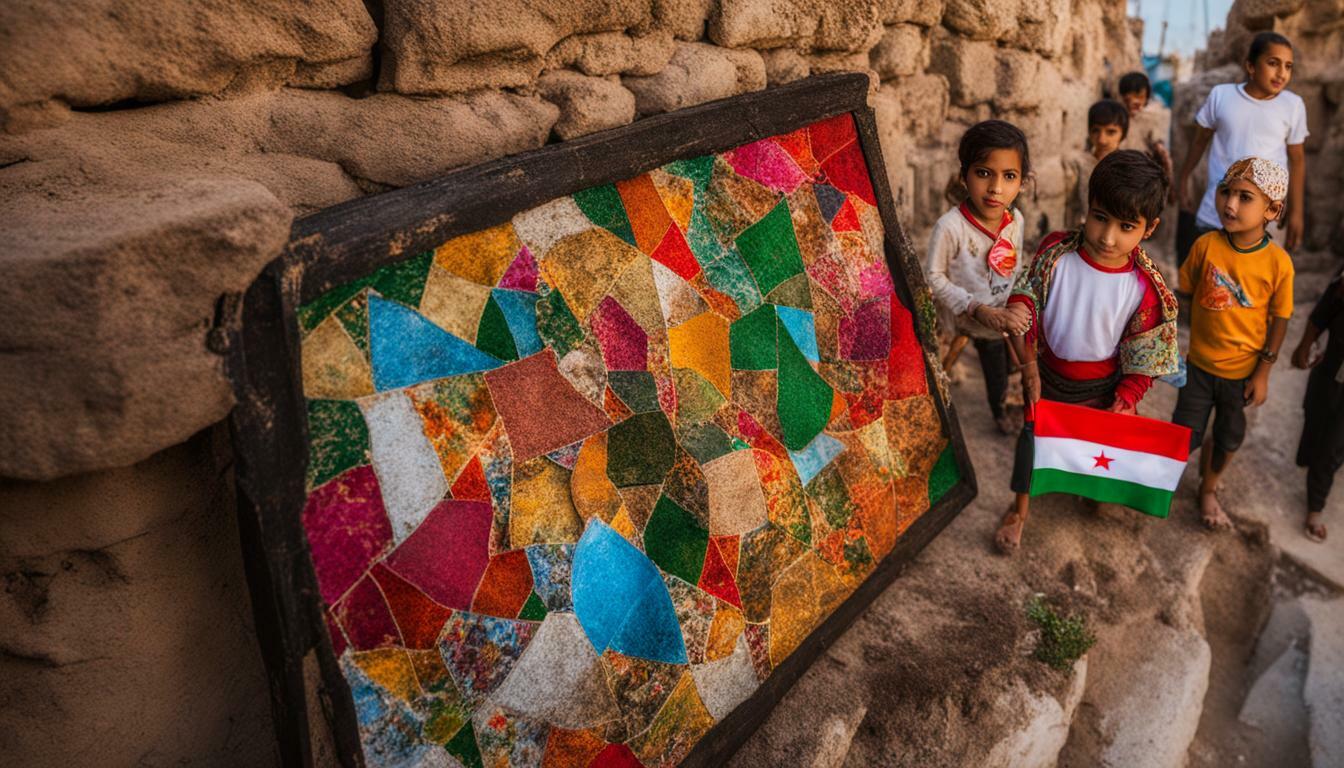Syria is a country rich in linguistic diversity, with a fascinating array of languages spoken throughout its regions. The official language of Syria is Arabic, and it is the most widely spoken language in the country. Several modern Arabic dialects are used in everyday life, with Levantine Arabic being prevalent in the west and Mesopotamian Arabic in the northeast. Additionally, there are several minority languages spoken in Syria, including Kurdish, Turkish, Neo-Aramaic, Circassian, Chechen, Armenian, and Greek. However, these languages do not have official status. Syrian Sign Language is the principal language of the deaf community in the country. English and French are also spoken by Syrian citizens, particularly in urban centers and among the educated population.
Key Takeaways:
- Syria’s official language is Arabic, with various dialects spoken across the country.
- Levantine Arabic is prevalent in the west, while Mesopotamian Arabic is spoken in the northeast.
- Minority languages, such as Kurdish, Turkish, Neo-Aramaic, Circassian, Chechen, Armenian, and Greek, are also spoken in Syria.
- Syrian Sign Language is the primary language of the deaf community in the country.
- English and French are spoken in urban areas and by the educated population.
Arabic: The Official Language
Arabic serves as the official language of Syria, and it is the most widely spoken language by its citizens. This beautiful language has a rich history and is deeply ingrained in the country’s culture and identity. In fact, Arabic has been influential in shaping the linguistic landscape of the entire region.
Within Syria, various modern Arabic dialects are used in everyday life. The Levantine Arabic dialect is particularly prevalent in the western parts of the country, including major cities like Damascus and Aleppo. This dialect is characterized by its melodic flow and unique vocabulary.
In the northeast, the Mesopotamian Arabic dialect is more commonly spoken. This dialect shares some similarities with the Arabic dialects spoken in neighboring Iraq and reflects the historical and cultural ties between the two regions.
“Language is the key to understanding a culture.” – Unknown
| Official Language: | Arabic |
|---|---|
| Prevalent Dialects: | Levantine Arabic, Mesopotamian Arabic |
| Minority Languages: | Kurdish, Turkish, Neo-Aramaic, Circassian, Chechen, Armenian, Greek |
| Sign Language: | Syrian Sign Language |
| Additional Languages: | English, French |
While Arabic is the dominant language in Syria, there are also several minority languages spoken throughout the country. These include Kurdish, Turkish, Neo-Aramaic, Circassian, Chechen, Armenian, and Greek. Though these languages contribute to the linguistic diversity of Syria, they do not have official status.
It is worth noting that Syrian Sign Language is the principal language of the deaf community in Syria. Developed organically by the local deaf community, it has its own distinct grammar and vocabulary.
English and French are also spoken by Syrian citizens, particularly in urban centers and among the educated population. These languages are often taught in schools and are commonly used in business and higher education.
Syrian Dialects: Linguistic Variation
The linguistic landscape of Syria is enriched by the diverse range of Arabic dialects spoken, with Levantine Arabic dominating in the western regions and Mesopotamian Arabic prevalent in the northeast. These dialects reflect the historical and geographical influences on the language and contribute to the fascinating linguistic tapestry of the country.
In the west of Syria, particularly in major cities like Damascus and Aleppo, Levantine Arabic is the most widely spoken dialect. It is also understood by speakers in neighboring countries such as Lebanon, Jordan, and Palestine. Levantine Arabic is characterized by its melodious intonation and unique vocabulary, setting it apart from other Arabic dialects.
On the other hand, Mesopotamian Arabic is spoken in the northeast, including areas like Raqqa, Deir ez-Zor, and Hasakah. This dialect has been influenced by neighboring languages like Kurdish and Turkish, resulting in some distinct features. Mesopotamian Arabic speakers are known for their distinctive pronunciation and vocabulary, reflecting the historical and cultural heritage of the region.
While Arabic is the primary language spoken in Syria, there are also several minority languages that contribute to the linguistic diversity of the country. Kurdish, Turkish, Neo-Aramaic, Circassian, Chechen, Armenian, and Greek are among the minority languages spoken by various communities in Syria. These languages reflect the multicultural nature of the country and contribute to its rich linguistic heritage.
| Language | Number of Speakers |
|---|---|
| Kurdish | Approximately 1.5 million |
| Turkish | Approximately 500,000 |
| Neo-Aramaic | Approximately 100,000 |
| Circassian | Approximately 80,000 |
| Chechen | Approximately 30,000 |
| Armenian | Approximately 10,000 |
| Greek | Approximately 3,000 |
In addition to these languages, Syrian Sign Language is the principal language of the deaf community in Syria. It is a unique visual language that allows individuals to communicate using hand gestures, facial expressions, and body movements.
English and French are also spoken in Syria, particularly in urban centers and among the educated population. English is often used in business and educational contexts, while French maintains its historical significance as a result of Syria’s colonial past. These languages contribute to the multilingual fabric of Syrian society, allowing for communication and cultural exchange with the international community.
The linguistic diversity of Syria is a reflection of its rich history and multicultural heritage. The varied Arabic dialects, alongside the minority languages and sign language, create a unique tapestry of communication that showcases the country’s vibrant linguistic landscape.
Minority Languages in Syria
In addition to Arabic, Syria is home to a number of minority languages, such as Kurdish, Turkish, Neo-Aramaic, Circassian, Chechen, Armenian, and Greek, each reflecting the cultural diversity within the country.
The Kurdish language is spoken by the Kurdish population in northern Syria. It is an Indo-European language and is part of the Western Iranian branch. With its rich history and strong cultural identity, the Kurdish language plays an important role in the lives of many Syrians.
Turkish, another widely spoken minority language in Syria, is primarily used by the Turkish communities living in border areas. It belongs to the Turkic language family, and its presence in Syria is a result of historical migration and cultural exchange between the two countries.
Neo-Aramaic, a Semitic language, is spoken by small communities of Assyrians and Chaldeans in Syria. This ancient language has its roots in the Aramaic spoken during the time of the Assyrian and Babylonian empires and is considered an important part of the region’s linguistic heritage.
Cultural Preservation
The Circassian, Chechen, Armenian, and Greek languages are also spoken by their respective ethnic communities in Syria. These languages, although not officially recognized in the country, are cherished by their speakers as a means of preserving their unique cultural identities and heritage.
While the linguistic diversity in Syria is significant, it is important to note that Arabic remains the dominant language and is widely used across the country. The presence of these minority languages, however, highlights the rich tapestry of cultures and traditions that make up the Syrian society.
| Language | Language Family | Speakers |
|---|---|---|
| Kurdish | Indo-European | Approximately 3 million |
| Turkish | Turkic | Approximately 200,000 |
| Neo-Aramaic | Semitic | Approximately 80,000 |
| Circassian | Northwest Caucasian | Approximately 50,000 |
| Chechen | Nakh-Daghestanian | Approximately 20,000 |
| Armenian | Indo-European | Approximately 6,000 |
| Greek | Indo-European | Approximately 2,000 |
Syrian Sign Language and Other Languages
Syrian Sign Language plays a vital role in the deaf community of Syria, providing a means of communication and expression for individuals who are deaf or hard of hearing. This unique visual language has developed over time and is used by the deaf community across the country. While Arabic is the official language of Syria, Syrian Sign Language serves as an essential tool for deaf individuals to communicate with one another and participate fully in society.
In addition to Syrian Sign Language, English and French are widely spoken in Syria, especially in urban areas and among the educated population. English, as a global language, is often taught in schools and universities, and it has become increasingly prevalent in business, tourism, and international communication. French, on the other hand, has historical significance due to Syria’s colonial past. Many Syrians still have a strong command of French, and it continues to be used in various professional settings.
“Language is the road map of a culture. It tells you where its people come from and where they are going.” – Rita Mae Brown
| Language | Usage |
|---|---|
| Syrian Sign Language | Used by the deaf community in Syria |
| Arabic | The official language of Syria |
| English | Spoken widely, especially in urban areas |
| French | Has historical significance and used professionally |
Language is an integral part of a culture, reflecting its history, diversity, and aspirations. In Syria, Syrian Sign Language, English, and French all contribute to the rich linguistic tapestry of the country, enabling communication and fostering understanding between different communities.
Conclusion
The linguistic diversity in Syria, with Arabic as the official language and a multitude of dialects and minority languages, is a testament to the rich cultural heritage found within the country. Arabic, being the most widely spoken language, holds a significant position in everyday life, with various dialects prevailing in different regions of Syria. Levantine Arabic is commonly used in the western part, while Mesopotamian Arabic is predominant in the northeast.
In addition to Arabic, Syria is home to numerous minority languages, including Kurdish, Turkish, Neo-Aramaic, Circassian, Chechen, Armenian, and Greek. Although these languages are spoken by specific communities, they do not possess official status in the country.
Syrian Sign Language plays a crucial role within the deaf community, serving as the principal language for communication. Furthermore, English and French are also spoken by many Syrians, particularly in urban areas and among the educated population.
The linguistic landscape in Syria reflects the nation’s diverse cultural fabric. The richness of language diversity, encompassing Syrian Arabic, various dialects, minority languages, Syrian Sign Language, and the influence of English and French, highlights the multi-faceted nature of the country and its people.
FAQ
What is the official language of Syria?
The official language of Syria is Arabic.
What are the different dialects of Arabic spoken in Syria?
Several modern Arabic dialects are used in everyday life, with Levantine Arabic being prevalent in the west and Mesopotamian Arabic in the northeast.
What are the minority languages spoken in Syria?
In addition to Arabic, there are several minority languages spoken in Syria, including Kurdish, Turkish, Neo-Aramaic, Circassian, Chechen, Armenian, and Greek. However, these languages do not have official status.
What is the principal language of the deaf community in Syria?
Syrian Sign Language is the principal language of the deaf community in Syria.
Are English and French spoken in Syria?
Yes, English and French are also spoken by Syrian citizens, particularly in urban centers and among the educated population.



